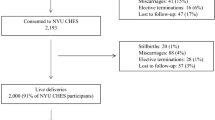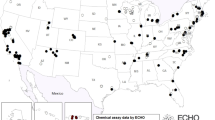Abstract
Environmental exposures during pregnancy have a lasting impact on children’s health. We combined environmental and maternal risk factor survey data to inform efforts to protect children’s health. We made recommendations for future use of such data. A modified version of the Pregnancy Risk Assessment Monitoring System (PRAMS) mail survey was conducted based on weighted sampling design with low-income and non-low income women in Monroe County, NY (1,022 respondents). A series of environmental questions were included in the questionnaire. Data were analyzed using Chi square tests and Poisson loglinear regression model to identify patterns in environmental health risk and sociodemographic characteristics. We identified women who rented their homes, had lower incomes, and lived in inner city zip codes as “high environmental health risk” (HEHR). HEHR respondents were more likely to report that a health care provider talked with them about lead and on average reported more behaviors to protect their children from lead poisoning. Combining environmental and perinatal risk factor data could yield important recommendations for medical practice, health education, and policy development. However, at present PRAMS gathers only limited and inconsistent environmental data. We found that existing PRAMS environmental questions are insufficient. Further work is needed to develop updated and more comprehensive environmental health survey questions and implement them consistently across the country.
Similar content being viewed by others
References
Bellinger, D., Leviton, A., Waternaux, C., Needleman, H., & Rabinowitz, M. (1987). Longitudinal analyses of prenatal and postnatal lead exposure and early cognitive development. New England Journal of Medicine, 316(17), 1037–1043.
Goyer, R. A. (1996). Results of lead research: Prenatal exposure and neurological consequences. Environmental Health Perspectives, 104(10), 1050–1054.
Mahaffey, K. R. (1999). Methylmercury: A new look at the risks. Public Health Reports, 114(5), 396–399. 402-13.
Weiss, B. (2000). Vulnerability of children and the developing brain to neurotoxic hazards. Environmental Health Perspectives, 108(Suppl 3), 375–381.
Landrigan, P. J., Schechter, C. B., Lipton, J. M., Fahs, M. C., & Schwartz, J. (2002). Environmental pollutants and disease in American children: Estimates of morbidity, mortality, and costs for lead poisoning, asthma, cancer, and developmental disabilities. Environmental Health Perspectives, 110(7), 721–728.
Mozaffarian, D., & Rimm, E. B. (2006). Fish intake, contaminants, and human health: Evaluating the risks and the benefits. JAMA, 296(15), 1885–1899.
Swan, S. H., Main, K. M., Liu, F., Stewart, S. L., Kruse, R. L., Calafat, A. M., et al. (2005). Decrease in anogenital distance among male infants with prenatal phthalate exposure. Environmental Health Perspectives, 113(8), 1056.
Canfield, R. L., Kreher, D. A., Cornwell, C., & Henderson, C. R., Jr. (2003). Low-level lead exposure, executive functioning, and learning in early childhood. Child Neuropsychology, 9(1), 35–53.
Lanphear, B. P., Hornung, R., Khoury, J., Yolton, K., Baghurst, P., Bellinger, D. C., et al. (2005). Low-level environmental lead exposure and children’s intellectual function: An international pooled analysis. Environmental Health Perspectives, 113(7), 894–899.
Mead, M. N. (2008). Contaminants in human milk: Weighing the risks against the benefits of breastfeeding. Environmental Health Perspectives, 116(10), A427–A434.
Kraft, M. E., & Scheberle, D. (1995). Environmental justice and the allocation of risk: The case of lead and public health. Policy Studies Journal, 23(1), 113.
Mott, L. (1995). The disproportionate impact of environmental health threats on children of color. Environmental Health Perspectives, 103(Suppl 6), 33.
Corburn, J. (2005). Street science: Community knowledge and environmental health justice. Cambridge, MA: MIT.
Kjellstrom, T., Friel, S., Dixon, J., Corvalan, C., Rehfuess, E., Campbell-Lendrum, D., et al. (2007). Urban environmental health hazards and health equity. Journal of Urban Health, 84(3 Suppl), i86–i97.
Claudio, L., Torres, T., Sanjurjo, E., Sherman, L. R., & Landrigan, P. J. (1998). Environmental health sciences education—A tool for achieving environmental equity and protecting children. Environmental Health Perspectives, 106(Suppl 3), 849–855.
Trasande, L., Boscarino, J., Graber, N., Falk, R., Schechter, C., Galvez, M., et al. (2006). The environment in pediatric practice: A study of New York pediatricians’ attitudes, beliefs, and practices towards children’s environmental health. Journal of Urban Health, 83(4), 760–772.
Chepesiuk, R. (2007). Environmental literacy: Knowledge for a healthier public. Environmental Health Perspectives, 115(10), A494–A499.
Sutton, P., Woodruff, T. J., Perron, J., Stotland, N., Conry, J. A., Miller, M. D., et al. (2012). Toxic environmental chemicals: The role of reproductive health professionals in preventing harmful exposures. American Journal of Obstetrics and Gynecology, 207(3), 164–173.
Gilbert, B. C., Shulman, H. B., Fischer, L. A., & Rogers, M. M. (1999). The Pregnancy Risk Assessment Monitoring System (PRAMS): Methods and 1996 response rates from 11 states. Maternal and Child Health Journal, 3(4), 199–209.
Shulman, H. B., Gilbert, B. C., Msphbrenda, C. G., & Lansky, A. (2006). The Pregnancy Risk Assessment Monitoring System (PRAMS): Current methods and evaluation of 2001 response rates. Public Health Reports, 121(1), 74–83.
PRAMS: Methodology [Internet] 2012. Available from http://www.cdc.gov/prams/methodology.htm.
PRAMS phase five questionnaire topic reference [Internet] 2012. Available from http://www.cdc.gov/prams/PDF/Phase5_TopicsReference.pdf.
PRAMS: Phase six questionnaire topic reference [Internet] 2012. Available from http://www.cdc.gov/prams/PDF/Phase6_TopicsReference.pdf.
Dozier, A., Brownell, E., Guido, J., Yang, H., Howard, C. & Doniger, A. et al. Adapting the pregnancy risk assessment monitoring survey to enhance locally available data: Methods. Submitted to MCHJ.
Jacobs, D. E., Clickner, R. P., Zhou, J. Y., Viet, S. M., Marker, D. A., Rogers, J. W., et al. (2002). The prevalence of lead-based paint hazards in US housing. Environmental Health Perspectives, 110(10), A599–A606.
Private drinking water wells [Internet] 2012. Available from http://water.epa.gov/drink/info/well/index.cfm.
Petersen, R., Connelly, A., Martin, S. L., & Kupper, L. L. (2001). Preventive counseling during prenatal care: Pregnancy Risk Assessment Monitoring System (PRAMS). American Journal of Preventive Medicine, 20(4), 245–250.
Bachman, J. G., & O’Malley, P. M. (1984). Yea-saying, nay-saying, and going to extremes: Black-white differences in response styles. Public Opinion Quarterly, 48(2), 491–509.
Boyce, S & Hood K. (2002). Lead poisoning among young children in Monroe County, NY: A needs assessment, projection model, and next steps. Center for Governmental Research.
Oregon PRAMS: 2004 results [Internet] 2012. Available from https://public.health.oregon.gov/HealthyPeopleFamilies/DataReports/prams/2004/Pages/mercury.aspx.
Korfmacher, K. S. (2008). Collaborating for primary prevention: Rochester’s new lead law. Journal of Public Health Management and Practice, 14(4), 400–406.
Korfmacher, K. S., Ayoob, M., & Morley, R. (2012). Rochester’s lead law: Evaluation of a local environmental health policy innovation. Environmental Health Perspectives, 120(2), 309–315.
Levin, R., Brown, M. J., Kashtock, M. E., Jacobs, D. E., Whelan, E. A., Rodman, J., et al. (2008). Lead exposures in US children, 2008: Implications for prevention. Environmental Health Perspectives, 116(10), 1285–1293.
Acknowledgments
This investigation was supported by PHS Grant # RO1-HD055191, Community Partnership for Breastfeeding Promotion and Support and a pilot Grant from NIEHS Grant P30 ES01247. The authors’ findings and conclusions do not necessarily represent the views of the funders.
Author information
Authors and Affiliations
Corresponding author
Rights and permissions
About this article
Cite this article
Korfmacher, K.S., Suter, B.J., Cai, X. et al. Environmental Risks and Children’s Health: What can PRAMS Tell Us?. Matern Child Health J 18, 1155–1168 (2014). https://doi.org/10.1007/s10995-013-1345-3
Published:
Issue Date:
DOI: https://doi.org/10.1007/s10995-013-1345-3




